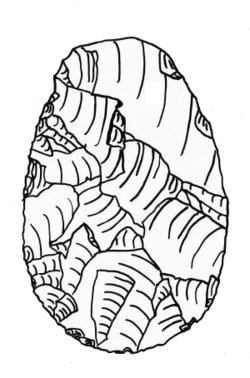Hand axe
|
|
A hand axe is a bifacial Paleolithic core tool. This kind of axe is typical of the lower (Acheulean) and the middle Palaeolithic (Mousterian) and is the longest used tool of human history.
| Contents |
Distribution
Handaxes are only found in Africa, Europe and Northern Asia, while South-Asia retained flake-industries (Hoabhinian).
Production
The older handaxes were produced by direct percussion with a stone hammer and can be distinguished by their thickness and a sinous border. Later (Mousterian) handaxes were produced with a soft billet of antler or wood an are much thinner, more symmetrical and have a straight border.
An experienced knapper needs less than 15 minutes to produce a handaxe.
Raw materials
Handaxes are mainly made of flint, but rhyolites, phonolites, quarzites and other rather coarse rocks were used as well. Soft materials like obsidian were rarely used.
Shapes
Several basic shapes, like cordate, oval, triangular etc. have been distinguished, but their chronological significance is not agreed upon.
Function
As most handaxes have a sharp border all around, there is no agreement about their use. Interpretations range from cutting and chopping tools to digging implements, flake cores, the use in traps and a purely ritual significance, maybe in courting behaviour. There are no indications of hafting, and indeed some artifacts are far too large for that.
Sources
- A. S. Barnes/H. H. Kidder, Differentes techniques de débitage à La Ferrassie. Bull. Soc. Préhist. Franç. 33, 1936, 272-288.
- C. A Bergmann/M. B. Roberts, Flaking technology at the Acheulean site of Boxgrove, West Sussex, England. Rev. Arch. Picardie, Numero Special, 1-2, 1988, 105-113.
- F. Bordes, Le couche Moustérienne du gisement du Moustier (Dordogne): typologie et techniques de taille. Soc. Préhist. Française 45, 1948, 113-125.
- F. Bordes, Observations typologiques et techniques sur le Perigordien supérieur du Corbiac (Dordogne). Soc. Préhist. Française 67, 1970, 105-113.
- F. Bordes, Le débitage levallois et ses variantes. Bull. Soc. Préhist. Française 77/2, 1980, 45-49.
- P. Callow, The Olduvai bifaces: technology and raw materials. In: M. D. Leakey/D. A. Roe, Olduvai Gorge Vol. 5. (Cambridge 1994) 235-253.
- H. L. Dibble, Reduction sequences in the manufacture of Mousterian implements in France. In: O. Soffer (Hrsg.), The Pleistocene of the Old world, regional perspectives (New York 1987).
- P. R. Fish, Beyond tools: middle palaeolithic debitage: analysis and cultural inference. J. Anthr. Res. 1979, 374-386.
- F. Knowles, Stone-Worker’s Progress (Oxford 1953).
- Marek Kohn/Steven Mithen Axes, products of sexual selection?, Antiquity 73, 1999, 518-26.
- K. Kuman, The Oldowan Industry from Sterkfontein: raw materials and core forms. In: R. Soper/G. Pwiti (Hrsg.), Aspects of African Archaeology. Papers from the 10th Congress of the Pan-African Association for Prehistory and Related Studies. Univ. of Zimbabwe Pubilcations (Harare 1996) 139-146.
- J. Merino, Tipologia Lithica. Munibe Supl. 9 (San Sebastián 19943).
- H. Müller-Beck, Zur Morphologie altpaläolithischer Steingeräte. Ethnogr.-Archäol.-Zeitschr. 24, 1983, 401-433.
- M. Newcomer, Some quantitative experiments in handaxe manufacture. World Arch. 3, 1971, 85-94.
- Th. Weber, Die Steinartefakte des Homo erectus von Bilzingsleben. In: D. Mania/Th. Weber (Hrsg.), Bilzingsleben III. Veröff. Landesmus. Vorgesch. Halle 39, 1986, 65-220.
Weblinks
Stone Age Hand Axes (http://www.abotech.com/Articles/Kowalski02.htm)

